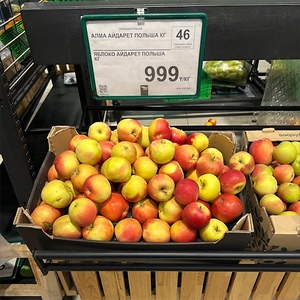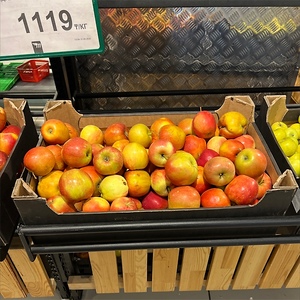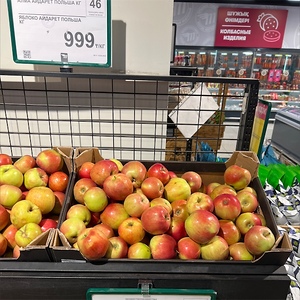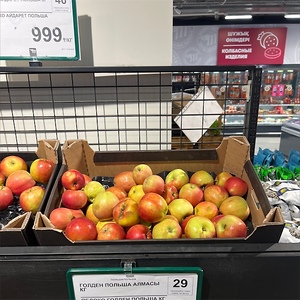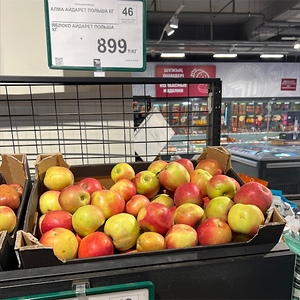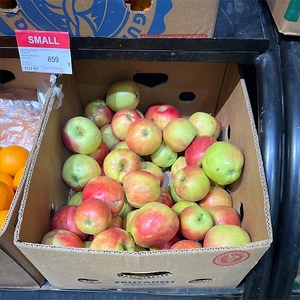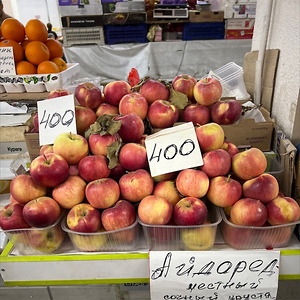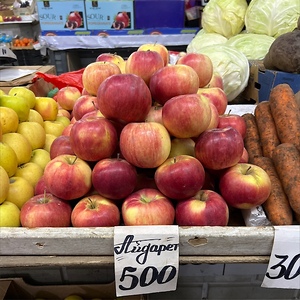

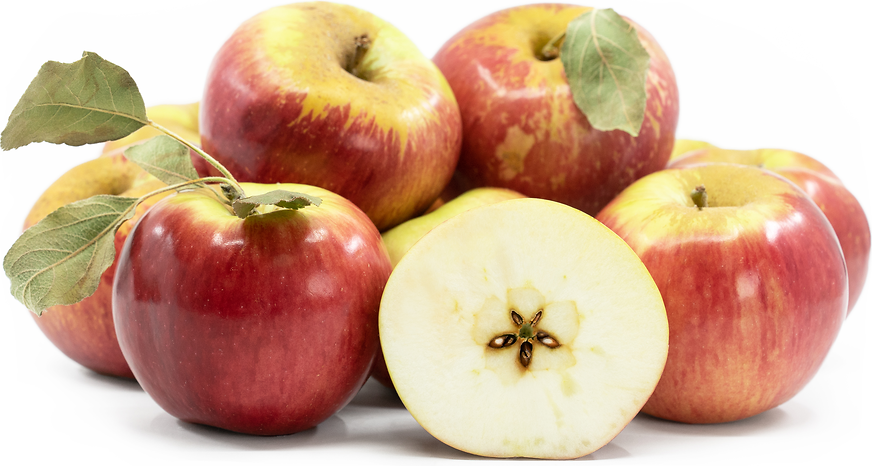
Idared Apples
Estimated Inventory, lb : 0
Description/Taste
Idared apples are a medium to large varietal with a round, ovate, to slightly flattened shape with broad shoulders tapering to a narrow base. The fibrous brown stems are short, and within the stem cavity, light brown russet occasionally occurs, giving the top a textured, sandy feel. Idared apples have thicker skin, creating a chewy mouthfeel, and the skin is smooth, taut, waxy, and glossy. The surface also has a yellow-green base, covered in a bright to dark red blush with prominent streaking. The red coloring will vary depending on sun exposure and the amount of time the fruits are left on the tree. Underneath the surface, the pale yellow to ivory flesh is sometimes tinted with pink and is fine-grained, aqueous, and firm with a crisp, crunchy consistency. The flesh also envelops a small central core filled with tiny black-brown seeds. Idared apples release a subtle aroma and are consumed ripe. When initially harvested, the apples have a sprightly, sharp, and sweet-tart taste. As the fruits are kept in storage, their flavor mellows and becomes refreshingly mild, sweet, and tangy.
Seasons/Availability
Idared apples are harvested in the late summer through fall. Once picked, the variety can be kept in cold storage for up to six months, sometimes lasting until June. It is said that the peak flavor develops in the fruits approximately three months after harvest, typically around January.
Current Facts
Idared apples, botanically classified as Malus domestica, are an American variety belonging to the Rosaceae family. The mid to late-season apples grow on trees reaching 3 to 4.8 meters in height, and the trees begin bearing fruit approximately 2 to 4 years after planting. Idared apples were named after their home state of Idaho and their rich, saturated red hues. The variety is sometimes written as two words, Ida Red, and growers favor the cultivar for its heavy yields and the fruit's ability to hang well on the tree. Idared apples also have extended storage capabilities, allowing the variety to be available almost year-round for culinary use. Idared apples are an American-born variety that has spread worldwide. The apples can be consumed fresh or cooked and are utilized in a wide array of preparations, especially in baked recipes.
Nutritional Value
Idared apples, like other bi-colored varieties, are a source of vitamin C to strengthen the immune system and fiber to regulate the digestive tract. The apples may also provide potassium to balance fluid levels within the body, vitamin K to assist in faster wound healing, calcium to build strong bones and teeth, vitamin A to maintain healthy organ functioning, and other nutrients, including manganese, zinc, copper, phosphorus, magnesium, and vitamin E. The vibrant red hues within the skin indicate the presence of anthocyanins, pigmented compounds with antioxidant-like properties to protect the cells against the damage and oxidative stress caused by free radicals.
Applications
Idared apples have a sweet-tart taste suited for fresh and cooked preparations. The variety initially has a sharper, tarter taste, but in extended storage, the flavor mellows and becomes milder and sweeter. Idared apples can be eaten straight out of hand, and the skin can be consumed or discarded, depending on preference. The apples can also be chilled for an enhanced, refreshing nature. Try chopping the apples into salads, shredding them into slaws, or mixing them into grain bowls. Idared apples can also be served with dips, including nut butter, caramel, and chocolate, sliced and layered into sandwiches, or added to parfaits as a crunchy ingredient. In addition to fresh preparations, Idared apples are valued for their baking qualities as they hold their shape well when cooked. The apples are popularly baked into pies, cakes, muffins, tarts, bread, and cookies, or they are simmered into sauces for roasted meats. In Australia, Idared apples are notably known for their use in strudels. Idared apples are also used to make a naturally pink-hued applesauce if cooked with their skins on. Beyond culinary preparations, Idared apples are sometimes used in cider blends. Idared apples pair well with cheeses such as blue, Roquefort, cheddar, and parmesan, nuts including pecans, walnuts, and almonds, spices such as cinnamon, nutmeg, ginger, and allspice, and herbs including mint, basil, parsley, and cilantro. Whole, unwashed Idared apples will keep for up to six months when stored in a cool, dry, and dark place such as the refrigerator.
Ethnic/Cultural Info
Idared apples are famously known for their use in baked apples. The variety's fine-grained, dense flesh allows the fruits to hold their shape when heated, and the core is removed and filled with savory or sweet ingredients. Historically, baked apples have been cooked for centuries, and the earliest recorded recipe dates back to 1685 London in a cookbook titled "The Accomplisht Cook." Baked apple recipes were also written throughout the 18th and 19th centuries in Europe, and in 1832, these recipes began to appear in the United States. Idared apples can be stuffed with sweet fillings such as candied nuts, spices, and brown sugar, or they can be stuffed with ground meats, quinoa, and other grains. There are many variations of baked apples in the United States, but Idared apples are primarily used in whole preparations to show off their ability to keep their shape. The apple's milder flavor also allows the flavors it pairs with to shine, acting as a neutral, edible container.
Geography/History
Idared apples are native to the United States and were created in the 1930s. The variety was bred by horticultural head Leif Verner at the University of Idaho's Agricultural Experiment Station in Moscow, Idaho, from a cross between Wagener and Johnathan apples. Both parent varieties were antique apples from Penn Yan, New York, and were developed in the 18th century. Idared apples were selected in 1935 as a new cultivar and were released after several years of evaluations to commercial markets in 1942. After their release, the variety spread through North American markets and was later planted in apple-growing regions worldwide, especially in Europe and Australia. The variety also received an Award of Garden Merit through the Royal Horticultural Society in 1993 as an outstanding home garden cultivar. Today, Idared apples are seasonally grown as a commercial variety and are sold worldwide in farmer's markets, grocers, and select distributors.
Recipe Ideas
Recipes that include Idared Apples. One
| Bonapetit |
|
Pork and Apple Sloppy Joes |



